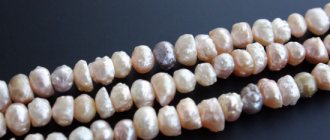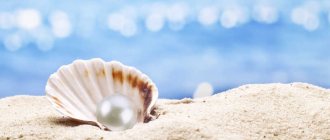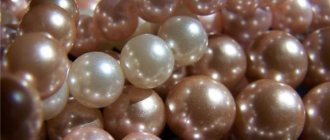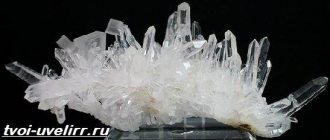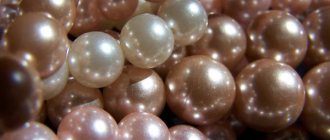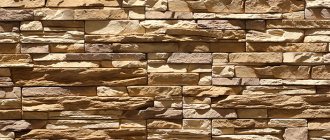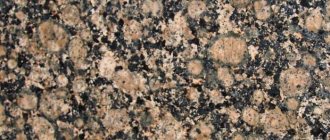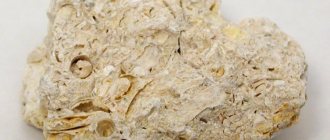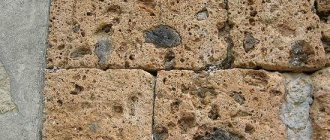Speaking about this unusual gemstone, it should immediately be noted that the word “baroque pearl” is written with an emphasis on the second syllable, which emphasizes its similarity to the baroque style. Not only the ideal shape of natural pearls can cause admiration. No less beautiful are their non-traditional varieties and forms in the form of a drop, pear, ellipse, button, tablet or capsule - this is only an incomplete list of possible variations. And each of them is the basis for imagination, a material that allows you to create unusual jewelry.
Baroque pearls - what are they?
The origin of baroque pearls is no different from classical ones. Once inside the oyster shell, every grain of sand or other solid particle is perceived by the hostess as an enemy. She tries to get rid of it by secreting a special spongy liquid. When the first layer petrifies, the oyster repeats its actions again.
Thus, the pearl “grows”. The unevenness of the sediment is the cause of the bumpy surface of the pearl. Its diameter increases by 3.2-4 mm per year. The formation of a pearl, which is used to make jewelry, takes several tens of months.
Baroque pearls - such an amazing marriage
Many people believe that baroque pearls are a waste. However, it is not. Each baroque pearl is unique. It has its own shade of color, shape and size. This makes it much more difficult to complete a multi-piece piece, let alone a set. Irregularly shaped pearls clearly emphasize their luxury and class as luxury items. These include the most famous stones.
The most famous pearl, the Hope Pearl, weighs 90 grams and its color can vary from whitish to golden with greenish highlights. Its length is just over 50 mm, the largest cross-section is 114 mm, and the smallest is 83 mm.
Another exclusive product is La Peregrina pearls. Literally translated as “wandering pearl,” the piece graced the collections of ruling houses in Europe and England for many years. It is shaped like a perfect pear, weighs almost 6.5 g and has a diameter of 23.8 cm. “La Peregrina” is pure white, which emphasizes its perfection. The pearl is listed in the Guinness Book of Records as a stone worth 10 million dollars.
The Jewel of Allah is another example. The history of this pearl dates back to the sixth century BC. The founder of Taoism, Lao Tzu, made an amulet with portraits of Buddha, Confucius and a self-portrait and placed it in a shell. The resulting pearls were passed down from generation to generation and placed in increasingly larger shells. It was eventually discovered in the Philippines. The pearl grew to almost 24 cm in diameter and weighed about 6.5 kg. The governor of the island, a Muslim, recognized the find as a turbaned head. The Pearl of Allah was valued at $40 million.
Facts from the history of the stone
The oldest and most famous pearling site is in the Persian Gulf. From the end of the 19th to the beginning of the 20th century, almost the entire population of the coast was engaged in this craft. Even today, various types of gemstones, including baroque ones, can be found on the shores of the Persian Gulf.
They are also mined in the Red, Mediterranean and Adriatic Seas. Freshwater pearls can be found in rivers in Russia, China, Germany and North America.
The Baroque pearl has been revered by people since ancient times. The Egyptian queen Cleopatra loved pearls most of all. She had a large collection of various pearls. Legend has it that the queen drank a glass of wine in which this huge mineral was dissolved.
In addition to Cleopatra, this gemstone was revered by Louis Cartier, Elizabeth Taylor, Coco Chanel and Princess Diana.
What stones does it go with?
Pearls are incompatible with sapphire, which reflects the surface of water. He does not like proximity to the stones of the Earth, especially jasper, cacholong, morion and chalcedony.
The optimal proximity is with other water (except sapphire) stones:
- emerald;
- opal;
- moonstone;
- aquamarine;
- alexandrite.
Acceptable partnership with Air:
- amethyst;
- uvarovitis;
- topaz;
- hyacinth;
- chrysoprase;
- smoky quartz.
Carefully!
Avoid proximity to Fire minerals, especially ruby, diamond and all types of garnets, including greenish grossular.
Variety of Baroque pearls
It is not entirely correct to talk about artificial pearls; Every pearl, even those grown on artificial plantations, is created by living beings. Baroque pearls are grown in large quantities in Japan. Natural organic stones of the most strange shapes, sizes and colors are grown here.
- The following varieties can be distinguished:
- freshwater and sea pearls;
- cultivated and natural or wild.
We will not talk about Chinese products made of rough glass and paint; these are not synthetic materials, but only cheap imitations that have nothing in common with jewelry.
Saltwater cultured pearls mature faster and have a larger shape. Freshwater pearls are inferior in caliber, but superior in quantity. A sea mollusk can bear one, but large, pearl for several years.
Several medium-sized and small-sized pearls grow simultaneously in the shell of a freshwater pearl mussel. Differences in growth are associated with the composition of the water: there are incomparably more mineral salts in the sea.
The specific growth of a baroque pearl is reflected in its price. Freshwater pearls are larger, smaller and cheaper. The price of saltwater pearls varies depending on the production method, size and color of the pearl.
The most expensive pearls are wild, large pearls. This is one that is inherited from generation to generation without changing its appearance or losing its value.
SECRETS OF A GREAT PURCHASE
The proportionality and uniformity of beads in a piece of jewelry is one of the criteria for its value.
It is difficult to select identical baroque pearls due to the variation in configuration, size, depth and nature of the relief. Therefore, items with well-fitted baroque pearls may cost more than similar items made from regularly shaped pearls.
Authentication of baroque pearls
The original or a fake
Baroque pearls are much more difficult to counterfeit than regularly shaped pearls. The fact is that it is almost impossible to artificially recreate the fantasy surface and characteristic shimmer of mother-of-pearl.
However, if in doubt, you can distinguish artificial jewelry from natural baroque pearls by the following signs:
- regularly repeating surface relief is a clear sign of a fake, since nature does not create identical shapes;
- the surface is too smooth - if you lightly run the edge of a tooth over a natural baroque pearl, you can feel the “sandy” structure;
- a clear boundary between the bead and the upper mother-of-pearl layer - this is only possible in synthetic beads; natural pearls consist entirely of mother-of-pearl and do not have a clear boundary between the inner and outer parts.
Natural baroque pearls
Wild Baroque pearls are pearls found by chance in the sea. Industrial mining of wild organic stone has been discontinued. Today it has been replaced by cultivation. The Japanese were leaders in this field until 2011.
The tsunami significantly disrupted this area of Japanese industry, allowing China to take the lead. However, Japanese traditions and unique technologies are gradually regaining their lost positions.
It should be noted that a positive result is obtained in only one out of ten shells. The mussel may sink into the substrate, form a baroque pearl, or fail to survive the operation. Add to this the seven years it takes for the mollusk to surround the foreign body in the sponge, and the price of the jewel becomes clear.
Pearl breeding allows you to grow pearls of a specific shape. In China, a pearl Buddha is obtained in this way by placing an image of his figure in a mollusk shell.
History of appearance
The formation of a pearl in natural conditions sometimes takes several decades. Artificial cultivation significantly reduces the time frame. In this case, the process of mineral formation is identical to the action occurring under the influence of natural factors with the only difference being the artificial placement of the core of the future pearl into the shell of a mollusk.
The oyster's response is to produce nacre, which begins to cover the base in a thin layer. The more layers, the richer and purer the shade of natural “sea stone”. If the color of a pearl depends on the type of mollusk, then the shape depends on the location of the nucleus, the ribbing of the shell walls and the presence of foreign bodies.
Baroque pearls are most often formed when they develop in the area of the valves or when the mineral comes into contact with the inner walls of the shell. The larger the contact area, the more unusual the shape of the “final product”. Pearls of this type can be cultivated in both sea and fresh water conditions.
This variety owes its name to the style of the same name. Barocco means baroque in Italian and unpolished in Portuguese. Raw pearls of unusual shape, but amazing texture and shine, quickly gained popularity in high society.
Earrings, pearl necklaces and pendants set in precious metals were made from pear-shaped and teardrop-shaped stones. Each such product was unique, and the history of the most famous of them is closely connected with the fate of great personalities: Cleopatra, King Philip II of Spain, Elizabeth Taylor.
Be sure to watch: Heliotis - a magic stone: fact or fiction?
Imitation baroque pearls
The leading producers of organic artificial stones are the United States of America. Currently, about 80 percent of the mass market for pearl jewelry is cultured pearls.
The history of its origin goes back to India, where in the 15th century it was invented to coat a clay ball with a mother-of-pearl composition made from mollusk shells.
Currently, the best technology is to obtain organic stone from a natural, natural material - a pearl shell. Americans coat pieces of shell with powdered natural gobber, layer by layer, just as it occurs in nature.
Artificial pearls have the same composition as natural ones, but their structure is denser, smoother, and more perfect in shape. The average size of such beads is from 10 mm.
Pearls in jewelry
Pearl necklace
Pearl is the only jewelry material that is formed in the body of mollusks, and it is also perhaps one of the oldest used as jewelry, since it does not require additional processing.
For centuries, high-quality pearls fetched very large sums of money, but this price premium was brought to an end with the advent of cultured pearls in the 1920s. The invention and implementation of successful pearl culture technologies is associated with the name of Kokichi Mikimoto.
Imitation pearls have recently been widely used as a popular component for creating jewelry and homemade jewelry. Modern technologies make it possible to create artificial pearls of any size, shape and color; Moreover, the cost of such pearls is significantly lower than natural ones.
Varieties of Baroque pearls
Baroque pearls are not a homogeneous stone with the same properties. There are several groups of them, among which the most common are sea pearls. Looking at them, you can distinguish the silhouettes of animals or their parts: bird wings, horse heads, frog heads, dog teeth, fragments of the human body, etc. Such pearls have a specific name: receipts. Many people associate them with magical properties and attribute miraculous effects to them.
Baroque pearls come in different types. Most of them get their name from the place where they come from. There are several marine and freshwater varieties, differing in color, shape, or both.
Kasumi
"Signature" Japanese baroque pearls, which are produced by specially farmed freshwater oysters that live at the bottom of Lake Kasumigaura.
Each pearl can have a unique color - from pale lilac to deep purple.
Kasumi beads are ellipsoidal, irregular in shape, slightly elongated, have a grooved surface and a diameter of 9 to 13 mm. The closer the color is to purple, the higher the price of kasumi beads; Given the large thickness of the mother-of-pearl layer, one pearl can cost up to $200.
No more than 5,000 real kasumi pearls are mined annually, but a cheaper analogue, “kasumi light,” is grown in China and Australia. It is difficult to distinguish the “light” version from Japanese pearls by color; this can only be done by jewelers who specialize in this mineral.
They are mainly used for making necklaces and earrings.
Mabe
Pearls cultured in salt water have an original shape in the form of “tablets,” disks or rectangular bubbles, in the center of which there is a thickening, or core.
Mabe is produced by implanting a nucleus—a grain of sand squeezed out of fragments of an invertebrate's own shell—not into the mantle, the mollusk's soft shell, but between the mantle and the shell, so that the nucleus fuses with the shell.
After a few years, when the pearl has grown, it is cut out along with part of the shell, so that the mabé can be any shape the maker desires.
Keshi
One of the popular types of baroque pearls, usually white or light silver in color. "Keshi" means "grain" in Japanese.
In size and shape, these pearls are similar to small grains of some plants.
Keshi pearls are oblong, small, about 4-6 mm. They are obtained by opening shells at pearl farms, which are supposed to produce round pearls. Keshes are a kind of mockery of nature; they are made from foreign objects that accidentally entered the intestines of a mollusk, that is, grains of sand, small stones and the like.
Keshis accompany "normal" cultured spherical pearls. They are both freshwater and marine. It is valued lower than round pearls, but individual specimens of such pearls, due to their unusual shape, can be very expensive.
Biwa
Biwa is a large freshwater lake in Japan on the island of Honshu. A special type of oyster is grown there, from which they produce seedless pearls of a very beautiful shape, reminiscent of ice needles or icicles.
Biwa pearls range in color from milky white, cream and pink to greenish or even blue. It is not highly prized, but is popular with jewelers who create jewelry for an audience that enjoys an unconventional, informal approach.
Buying genuine biwa pearls is quite difficult since many of the “counterfeit likenesses” come from China.
However, in appearance they are practically indistinguishable from the Japanese original.
Souffle
This is a rare type of baroque cultured pearl that is hollow inside.
This is achieved by placing a porous, moisture-absorbing material in a pearl sac - a tissue cavity formed by a mollusk on the surface of a foreign body trapped in the mantle. As a result of the expansion of the sponge, the volume occupied by the foreign body increases, and the mollusk is forced to cover a much larger area with the sponge.
The result is a large, irregularly shaped pearl. After removal, it is cut, the sponge is removed, and a gem or other decoration is placed into the resulting cavity.
Jewelry with oddly shaped pearls
Beginners in jewelry love to hone their skills on baroque pearls, as they are easy to process and difficult to spoil. This type of Burmitz grain is not suitable for the mass creation of products, since there are not so many true connoisseurs of this mineral; most prefer necklaces made from perfectly round beads.
But there are still real masters in the world who love and know how to handle unusual-looking pearls and create real masterpieces from them; Rene Lalique and Lydia Courtel can be counted among such professionals. These jewelers created amazing things from baroque pearls that had never been created before by anyone.
By purchasing jewelry with fancy-looking pearls, you can make your image individual and sophisticated at a fairly reasonable cost, especially since the Barocoque-style mineral has all the qualities of its spherical counterparts.
Goodbye, dear readers! Don't forget to subscribe to our updates and tell your friends about interesting articles using social networks.
Non-pearl pearls
Non-pearl pearls should be discussed separately. They do not belong directly to the Baroque variety, since they are mainly round in shape. However, the lack of shine of pearls does not allow them to be classified.
Pearl Melo Melo
These rare pearls are created by large Melo Melo snails that live off the coasts of Thailand, Vietnam, Burma and Cambodia. Snails simply don't produce nacre, so not all experts consider chalk beads to be pearls. However, major gemological organizations classify Melo as a “non-pearl” pearl in their certificates.
- Size up to 2.5 cm
- Round or oval shape
- Color: yellow to red and brown
- The most valuable specimens are yellow and orange
They glow due to spots or elongated bright spots. Found only in the natural environment, pearls react to bright light, losing their saturation
Quahog pearls
These natural beads are also called non-pearls. Quahog comes from the shellfish Venus mercenaria, which is typically used as food rather than for jewelry.
- Size: usually 5 to 6 mm
- The size of the largest pearl is 14 mm.
- Round or oval shape
- Color: milky to purple, almost black
- The most valuable varieties are purple and lilac with variations.
Melo Pearl - fiery pearl
The magnificent orange Melo pearls are found in Melo melo snails. They live along the coastal regions of Indonesia, Thailand, Cambodia and Vietnam. The size of their shell is from 15 cm to 30 cm. The older and larger the snail, the larger the pearl, that is, it is impossible to find a large pearl in young specimens. The Melo pearl does not have nacre, but it has a silky, fire-like texture and porcelain luster. Pearl colors range from bright orange to almost white. In reality, there are species that combine several shades. Pearls of a bright orange color are most valued, and the fiery flashes should be clearly visible. All Melo pearls, like Conch pearls, are natural; attempts to grow cultured pearls have ended in failure. Pearls are ovoid, oval, baroque or spherical in shape, which are the most expensive.
The most famous Baroque pearls
There are many stories around the world related to the Baroque pearl. The famous Hope Pearl is one of the largest in the world, weighing about 90 g. The gem shimmers in shades of white, gold and even green. The mineral is named after its owner, Henry Hope, who lived in the 19th century.
Another famous gem is La Peregrina, which means “incomparable.” It is pear-shaped and white in color. The Spanish king gave this gem to his wife, and she inherited it from an American sailor who received it from a slave in exchange for freedom. In the 1960s, it was purchased by Elizabeth Taylor, who kept it for her entire life and then sold the gem at auction.
The magical and healing properties of Burmese baroque pearls
A naturally occurring mineral in any shape, it is believed to have healing and magical properties. Pearls can absorb negative energy, eliminate headaches, normalize the digestive tract, stabilize hormones and much more.
It is also believed that pearls are more suitable for jewelry intended for women; men very rarely wear jewelry with them. For its owner, the mineral can provide protection from bad people and misfortunes. Pearls have always been considered the ideal accessory for brides. Today, even very young girls wear bracelets, earrings, and beads made from this unusual type of mineral.
A pearl is a symbol of purity, wisdom and fidelity. Since time immemorial, many people have believed in its miraculous rejuvenating powers. According to astrology, this mineral is well suited for those born under zodiac signs with the water element.
It is believed that the pearl and its owner become one over time, and if the owner of the pearl is often angry, worried and nervous, the mineral begins to lose its luster and deteriorate.
By choosing such jewelry, every woman will feel much more attractive and confident.
Not only will a necklace protect you from evil influences, but it can also benefit your health by relieving you of stress and depression.
Properties of the stone
In terms of physical and chemical properties, a baroque mineral differs little from a spherical one. Consists of inorganic calcium salts and horny substance - conchiolin. These compounds are produced by the body of the mollusk in response to constant injury and irritation.
Baroque pearls come in a variety of shades. Beads of white or silver color are more common, and occasionally dark purple or black stones are found. The color of minerals depends on the type of mollusk and external conditions.
Pearls are considered fragile stones. Its hardness on the Mohs scale does not exceed 4, that is, it is easily scratched by any sharp object. Stones are also sensitive to chemicals. Pearls dissolve instantly in concentrated acid solutions.
Medicinal properties
Lithotherapists and experts in oriental medicine attribute a number of healing properties to baroque pearls. It is worth noting that it is Baroque pearls that are used to make medicines.
The mineral has a beneficial effect:
- on the skin;
- musculoskeletal system;
- kidneys and urinary tract;
- hormonal background;
- digestive organs;
- cardiovascular system.
In the East, people used pearl powder to treat skin diseases, heal wounds and stop bleeding. Due to its high calcium content, the mineral is effective for the prevention and treatment of osteoporosis.
Pearls also have antioxidant and general strengthening effects. It slows down the aging process of the body, normalizes water-electrolyte balance and blood pressure. Because of these properties, pearls have been recognized as a stone that can combat age-related changes.
Magic properties
Pearls are a symbol of purity, innocence and youth. It is believed that talismans with these minerals protect the owner from evil views and thoughts.
It was customary to give jewelry with gems to young girls. Moreover, Baroque pearls were presented mainly to unmarried women or little girls. Such amulets should help a girl preserve her beauty and innocence.
Married women were given baroque pearl jewelry by their husband or his relatives. Such talismans helped maintain love and fidelity in relationships.
Baroque pearls can be worn by all zodiac signs. However, it shows maximum strength with representatives of the water elements: Cancer, Scorpio, Pisces. The stone enhances the positive qualities of the owner and suppresses his negative aspects.
Scorpios are one of the few signs who will benefit from wearing a black gem. The mineral helps the owner achieve success in his career and personal life.
How to store and care for baroque pearls
Like any other type of pearl, baroque pearls require careful handling and should be stored and cared for in accordance with the following recommendations.
The mineral does not like contact with chemicals, so it should be cleaned with a velvet or velor cloth.
- Pearls are afraid of active sunlight, so it is not recommended to wear them in summer.
- Baroque pearls should not be worn in a sauna or bathhouse.
- Pearls are not resistant to any changes in temperature and high humidity.
- Burmese pearls and jewelry made from them should be kept away from other minerals.
- Necklaces and bracelets made of pearls should be stored in boxes lined with velvet or in bags made of the same material.
- Pearl jewelry does not tolerate cosmetics well, so first apply perfume, deodorant, cream, etc., and only after 10-15 minutes put on the beads or necklace.
If you follow all the above tips, a product decorated with baroque pearls will last a long time.
Product care rules
Regardless of whether your pearls are set in gold or silver, whether the pearl is set in a ring, or decorates a pendant or pendant, it requires special care.
Mother of pearl is a fairly soft material, ranging from 2 to 4.5 Mohs units, so it is easily scratched or damaged.
In addition, any organic matter is characterized by an aging process; Conchiolin, which makes up the organic part of the mother-of-pearl layer, gradually loses its luster, turns black, and eventually the pearl crumbles.
Baroque pearl bracelet
There is no way to avoid this, but proper care of your pearls can slow down aging and extend the life of your jewelry up to 500 years, so that your descendants can enjoy it too.
Rules of care:
- Protect the product from bright sunlight.
- Avoid prolonged contact with moisture, and if this happens, do not dry quickly and at high temperatures.
- Do not wear on bare skin. Pearls easily absorb sweat, but the salt contained in human sweat and other body waste products destroy the mother-of-pearl surface.
Pearl beads are worn over the dress. Rings and earrings are made so that only the frame is in constant contact with the skin.
Pearl items can only be washed with water.
Do not use household chemicals, including ethyl alcohol. Do not use abrasive substances, even tooth powder. Domestos-type products are absolutely unacceptable.
The jewelry is carefully wiped with a soft cloth, dried on a clean soft cloth and stored separately from other precious stones in a box with soft inside walls.
Baroque pearls - precious stone or not
Baroque pearls, like traditional pearls, are classified as precious stones. It is formed in the insides of both sea and river mollusks. The best quality pearls grow in shellfish when they are still young. Thus, in the initial period of growth (1-2 years), pearls reach an average diameter of 2-3 mm. Later, its growth slows to 0.5 mm per year. Today, the vast majority of pearls are cultured pearls grown in special farms.
Who suits the name
Sunny pearls are ideal for a woman named:
- Valentina. The stone will emphasize her purity and purity.
- Marina. With his help, she will gain wisdom, calmness, become more attractive and avoid disappointments.
- Albina. The support of the mineral will bring her good luck, spiritual comfort and help preserve her family union.
- Hope. The magic of the stone will ensure her prosperity and longevity.
- Evdokia. The stone will protect her from meanness and fill her life with joy. Margarita. The precious mineral will bring harmony and peace into her life.
Sources and literature
- Biological encyclopedic dictionary / Ch. ed. M. S. Gilyarov; Editorial team: A. A. Baev, G. G. Vinberg, G. A. Zavarzin and others - M.: Sov. encyclopedia, 1986. - 831 p.
- Pearl // Encyclopedic Dictionary of Brockhaus and Efron: in 86 volumes (82 volumes and 4 additional). - St. Petersburg, 1890-1907
- Moskovskaya N. Shells of the world. History, collecting, art. - Aquarium-Print, Harvest, 2007. - 256 p.
- Srebrodolsky B.I. Zhemchug / Rep. ed. N. A. Sozinov; Rec.: O. V. Gorbachev. - M.: Nauka, 1985. - 136 p.
- Stephen Hutchinson, Lawrence E. Hawkins. Oceans. - M.: Makhaon, 2007. - P. 252-253.
- Voronov V. A. Pearl. - M.: Astrel, 2004. - 142 p.
- Etymological dictionary of the Russian language / Scientific. ed. N. M. Shansky. - M.: Moscow University Publishing House, 1973. - T. I. Issue. 5. - P. 284.
- Vasmer M. Etymological dictionary of the Russian language. - M.: Progress, 1964–1973. - T. 2. - P. 46.
- Farn A. Pearls: natural, cultured and imitation / Per. from English Ph.D. geol.-min. Sciences V.B. Aleksandrova and D.N. Khitarova. - M.: Mir, 1991. - 191 p.
- Description of pearls on the website ru.wikipedia.org
5 / 5 ( 1 voice )
